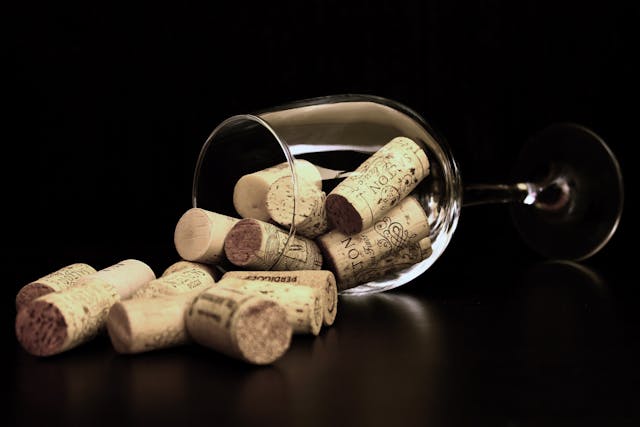
Where does cork come from? Cork comes from the bark of the cork oak tree.
The primary use of cork is to stop up wine bottles. About 20 billion bottles of wine are produced a year and about 80% of those bottles have cork stoppers in them. That is a huge amount of cork and that is how we know cork, but that hasn’t always been the case. Cork has had many different uses over time. It wasn’t used as a stopper in wine bottles until the late 17th century. Up until then, in Europe, wine bottles were stopped with oil-soaked rags. The Romans, for example, sealed their amphora with wax, or other perishable materials. Some used a lid made of the same material as the amphora. Cork has been used to seal jugs and other containers in China and Egypt for at least 5,000 years. It has had many other uses as well. It is very buoyant and has been used in boats and things that need to float. It was used to make sandals in Greece. It has even been used as a medicine.
So, where does cork come from? Cork oak trees grow in hot climates and they are generally found along the coast of the Mediterranean. Half of the world’s cork is produced in Portugal. The cork is the phellem layer of the bark on the tree. All trees have bark and all trees produce cork. It is just that the cork oat tree produces more cork than any other tree. Bark is the hard layer of the tree that protects it from injury or invading species. The bark is connected to the tree by the phloem, which is the part of the tree that transports water, sap, nutrients, and everything else that the tree needs. This is the part of the tree that is tapped for maple syrup. The job of the bark is to protect this layer.
The outer layer of bark is hard, but there are many other layers inside this outer layer. One of these layers is called cork. It is a spongy layer with lots of air pockets. Its job is to protect the tree from impacts, but also to insulate the part of the tree that carries water. The air pockets in the cork are water-resistant cells and they stop water from getting out of the tree. The cork in cork oak trees is much thicker than the cork in other trees because of where they are. The area around the Mediterranean is very hot and is prone to droughts and forest fires. The thick cork layer stops water evaporating out of the tree and protects it against dehydration. Cork is also fire resistant and can protect the tree against very high temperatures. Cork is a very versatile material. It is light, it won’t rot, it is resistant to heat and fire, it is soft, and it is impermeable to gas and liquid.
The cork is removed from the tree by someone called an extractor. The cork extractors don’t remove the cork from a tree until it is at least 25 years old. The first cork taken from the tree is usually of a low quality. The extractors make horizontal and vertical cuts in the tree, then use the handle of an axe to strip the bark off. It comes off very easily in a big sheet called a plank, but they have to be very careful that they don’t damage the phloem layer. They want to strip the bark, but not kill the tree. Cork farming is a sustainable business because the trees don’t die. After the bark has been removed, it grows back again. It takes about 10 to 12 years for the bark to completely regenerate and then it can be stripped again. The second time produces better cork. Cork trees can live for 250 years and they can be stripped between 12 and 17 times during their lifetime, although, of course, not by the same cork extractor.
Because the cork tree is not killed, it is a very environmentally friendly product. The trees provide stability for the soil and absorb carbon dioxide. Their canopies and roots cut down on flooding and soil erosion. They are habitats for many animals and birds. The cork is harvested by hand and the final product is completely biodegradable. One cork tree can yield enough cork for 5,000 corks, each time it is harvested. And this is what I learned today.
Photo by Pixabay: https://www.pexels.com/photo/brown-corks-on-clear-wine-glass-36741/
Sources
https://www.everysoulcounts.co.uk/fascinating-facts-about-cork-oak-tree
https://www.fs.usda.gov/learn/trees/anatomy-of-tree
https://home.howstuffworks.com/question550.htm
https://cycling-centuries.com/blogs/news/everything-you-could-ever-want-to-know-about-cork-trees
https://en.wikipedia.org/wiki/Cork_cambium
https://en.wikipedia.org/wiki/Cork_(material)
